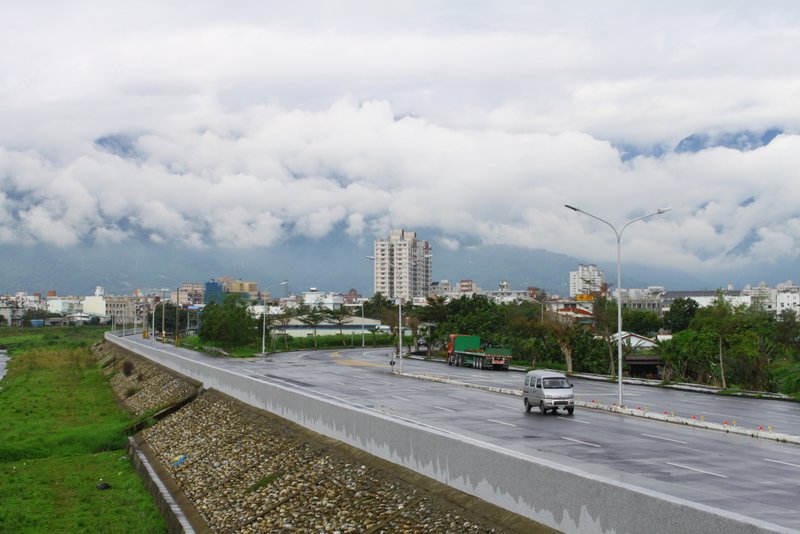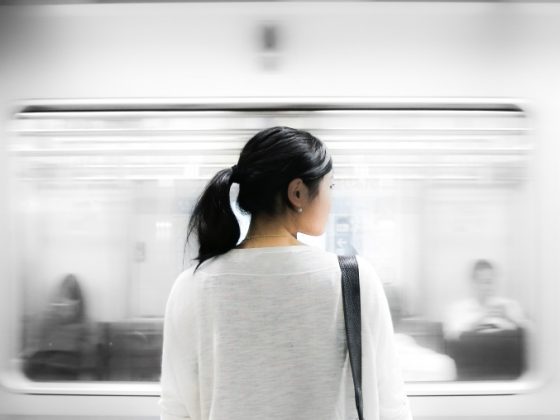Day One: Coastal Road and Cracking Bamboo

Route 11 stretches like a lazy python along Taiwan’s eastern coast. From north to south it’s roughly 300 miles of small towns, sheer-drop cliffs, dynamite-blasted tunnels, and many spectacular (and eminently surf-able) riptide heavy beaches. It’s a road for drivers with strong stomachs who are in no particularly hurry. Leaving Hualien early, we ride beneath watery skies, passing a series of strange statues from Chinese mythology in a parking lot overlooking the beach. At the far edge of the lot a group of travelers giggle and take pictures of something beyond the railing. It is a bare-chested mermaid sitting on a rock next to an arch bridge, wearing a Hawaiian lei.
Quirky Taiwan, I think.
We ride on, the sun playing peek-a-boo well into the afternoon, the road rising and dipping into long stretches of sheer jaw-dropping beauty. Larger towns have 7-11’s, and smaller villages, many of them aboriginal, generally have small family-run places with a handful of items on the shelves; instant noodles and biscuits. Always in the cooler are few varieties of Mr. Brown, a canned coffee-like beverage ubiquitous around the island.
All stores large or small have a crock pot of simmering tea eggs, hard boiled eggs cooked in a broth of tea. Slightly leathery, the tea egg travels well, making them a good snack for long stretches between towns.
At Niu Shan, a rest stop overlooking a brilliant section of coast I come across another excellent – and far less ubiquitous – caloric companion. Zhu tong fan; rice cooked in a bamboo stalk. Ostensibly an aboriginal dish (though tribal folk would have used millet, rice being a Han import), zhu tong fan may be the ultimate cycling food, high in carbohydrates and easy to carry. I crack the stalk on a rock, eating the sticky rice inside before tossing the biodegradable bamboo into the grass.
Past the phallic Tropic of Cancer monument we are officially in the Tropics. The sun is setting as we pull close to Sanxiantai, a scenic area that’s home to one of the east coast’s prettier human-created tourist attractions, the aptly named eight arches bridge. Legs in danger of seizing up after my first 120 kilometer ride in months, I opt for a few photos from the coastal side of the first arch.

It’s dark when we pull into the town of Chenggong and search out a seafood meal and a cheap guesthouse.
Day Two: Solo Buns and Mountain Passses
In the morning, our ad-hoc riding fellowship part ways, the other two cyclists having decided to continue down the east coast to catch an afternoon ferry to Green Island. Having already visited the island several times and endured the hour-long ferry ride (which I dubbed in my last Lonely Planet Write-up The Green Island Vomit Comet), I decide to head inland instead.
After a traditional Taiwanese quickie breakfast of danbing (a rolled up cheese omelet served with brown sauce and eaten with chopsticks) I continue solo south on 11, prompted to stop in front of a police station in the town of Duli, before which reads a sign: Bicyclist rest stop.
Officer Ma, a short, cheerful man, explains that his and three other stations along the coast have been designated as bicycle rest stops. and as such are equipped with air pumps, filtered water, and a grassy space out back where cyclists (or any traveler) can pitch a tent free of charge. There’s also a shower.
“Actually, it has long been the policy to let cyclists store their bicycles and camp out at most rural police stations around Taiwan,” Officer Ma tells me.

In the town of Donghe, just a few miles past Duli, I stop at Donghe Baozhi, famous for its steamed buns. So well known is the bun shop that a satellite tourist industry has sprung up it. I browse trinkets, buy a coconut, and sit down to chat with a man surnamed Lin, who has ridden his steel-framed mountain bike the 40 kilometers from Taitung to buy a dozen of buns for his family.
“This is my Sunday ritual, weather permitting.” He says.
I say goodbye to the coast and head into the mountains. After a brief stop for photos at the Donghe Bridge (famous for its Monkey colony), the road heads up steadily, a brutal and beautiful climb. The steady, curving, and seemingly endless route 23 climbs and climbs through the coastal mountains that lie between Taiwan’s coast and the Central Mountains, where the climbing is said to be truly serious. It’s mostly-uphill for 20K, with only the occasional dip (often heralded by sign) never long enough to be more than a tease.

Halfway up the mountain I am pouring sweat, sea breezes now history, and stop to eat the last of my Donghe veggie buns. The laws of physics, not to mention geology and geography, dictate that the road must head downhill at some point.
I close in on what I hope is the final summit. Valleys filled with trees and fields spread all around. For nearly an hour I’ve seen nobody, and now, up ahead, a group of five men stand surrounding a sixth lying on the side of the road. Parked neatly end-to-end are several motorcycles, and I realize that this is the group of riders who’d passed me an hour ago at the 10K marker. The man is propped up on his elbows comfortably, as if watching television.
What a lovely idea. I think. I’d like to join him.
Pulling closer it dawns that something is amiss, as lying on roadsides not a normal activity to men with motorcycles.
“Are you OK?” I ask the man on the ground.
“Except for the broken leg,” The man answers serenely, before explaining that he’d wiped out on a curve. I ask if he’s sure the leg is broken.
“Oh yes. It hurts terribly.”
“Can I do anything for you?”
“Thanks, no. The ambulance should be here soon. My friends are watching for traffic.”
I bid the man farewell and continue riding, the road ahead stretching into a glorious downhill. As I coast along, I find myself meditating on the stoicism of the Taiwanese, and also on the deeper meaning behind Taiwan’s place in the cycling world. From pouring resources into building up and promoting the nation’s bike-friendly nature to showering her bike producers with respect once reserved for the big high-tech players, Taiwan’s commitment to becoming to the bicycling world what France is to the culinary world borders on the religious.
As I ride downhill, I decide that this is part of a deeper need within the collective consciousness of Taiwan, which, at the risk of sounding foolish I now share with the reader: An intense need to be loved.
Why does Taiwan need so fiercely to be loved? Like most issues involving the nation’s relationships with the greater universe, the answer may lie in the heavy presence next door.
Consider Taiwan’s situation: A small, generally cheerful & largely prosperous democracy living a short-range surface-to-surface missile launch away from a massive and heavily armed totalitarian state that’s utterly convinced Taiwan is part of its sovereign territory. A major global player in every sense, said heavily armed state has for years told all within earshot that absorption of its “renegade province” will be done using any means necessary, and that the world had better keep its mouth shut when it finally happens.
Stripped of nearly all diplomatic allies (at least officially), this cheerful island nation has available only unofficial avenues with which to make itself beloved in the eyes of the world. Chief among these avenues: Becoming a top manufacturer of a product universally associated with health, happiness, and environmental well-being.
This, of course, is just a theory.

Another 6k of mostly-coasting brings me to Fuli. The ride across the coastal mountain has taken the better part of the afternoon. It’s 3:30, and I’m wasted enough to consider giving in and taking a train the final 45k to Rueishui, but the station master quickly quashes this idea.
“The next bike train leaves at seven.”
Feeling less than enthusiastic, I stretch cramped leg over the top tube and head north to Rueishiu, where the promise of hot-spring hotels await. I switch between route 9, which has a wide bike lane, and a recently built bicycle-only path paved over a former railway line. The ride is easy, the air is fragrant and cool, and the scenery mostly fruit trees and rice paddies, dotted by a few small temples and the occasional roadside shrine.

Along the way I pass dozens of local cyclists on everything ranging from ancient clunkers to state of the art racing bikes. Nearly all of the serious cyclists are wearing the cycling gear favored by the Taiwanese bike set – lycra shorts, long sleeves and cloth scarves that all but obscure their faces. I salute them as I pass, and find their attire strange. They wave back, and I can’t help but wonder what they think of my own cycling gear – camouflage shorts, a cut-off T-shirt, and many tattoos.

The final stretch leading into Rueishiu feels at least as steep as the Donghe-Fuli road, stretching for about 3 kilometers before flattening out at a hilltop tea shop surrounded by tea plantations.
From here I coast into town and check into the Hoya Spa Hotel, which boasts a series of natural mineral baths ranging in temperature from frigid to hot. In the main warm pool are a series of hot-spring gee-gaws featuring high pressure jets of many shapes and pointing in all directions. As high velocity geothermal water hits the spots on my back where sunblock never quite made it, I understand why local cycling fashion makes sense.
Burned and too exhausted to hunt anything fancier, I settle on the nearest barbeque stand and wolf down four orders of jipi – chicken ass on a stick, with a side of fried squid.
Day Three: Looping Back, Dumplings and Sashimi
After coffee and a morning soak, I head through surrounding rice fields to Route 9. I have decided the logical final day of the tour. On my government-issued map the final 75 kilometers form a neat loop, allowing me to return the bicycle to it’s home-shop and have supper at the seafront night-market in Hualien.
Route 9 is wide and my pace is slack. More picturesque (or so I’m told) is route 193, which runs parallel to 9 and meanders a bit more, but after two days of fairly intense riding I’m content to take the easier, softer way. I stop at a roadside café and brunch on vegetarian dumplings, stop again for iced coffee a few kilometers later in the two-street town of Guangfu, and again to stretch and take photos of a field filled with flowers and nesting cormorants.

I get sidetracked for thirty minutes, seduced by an unfinished four lane highway not yet open to traffic and ending at the base of a not-yet built bridge, and wind up mildly disoriented but not in a major way. At this point that the central and coastal mountain ranges form a pincher, funneling all traffic into the open plains south of Hualien city, making getting lost difficult.

Three hundred kilometers (give or take) and three days later am back where I started with enough time to grab some sashimi and watch the sun set behind the central mountains.
Looking to do a cycling tour in Taiwan? Starting in Let MyTaiwanTour customize a cycling trip for you!
Read more:
Cycling the East Coast with MyTaiwanTour (part one of two)
Cycling the East Coast with MyTaiwanTour (part two of two)
First Dawn Flight, Tribal Rites and Beautiful Taitung: A Unique Way to Spend New Years in Taiwan












Comments are closed.